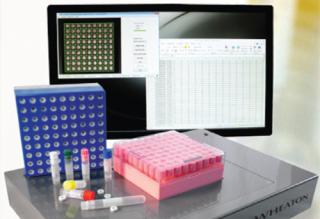Biobanking BasicsBiobanking Basics
May 1, 2012
With increasing large-scale “-omic” and clinical studies, the value and need for large and small biobanks or biorepositories has grown exponentially. Many organizations are processing and storing hundreds, thousands, even millions of biosamples. Those samples are collected from a number of sources, however, and put to end uses that are not always anticipated at collection. Consistent standards thus must be established to collect and store samples. Everyone involved must work toward a common goal of high-quality, consistent, reliable, and traceable sample storage. Standardization in biobanking best practices has produced minimum guidelines for ensuring biospecimen reliability.

Biobanks must be versatile and consistent. For example, samples need to be processed and stored appropriately for use in later assays. Each specific biomaterial (and sample use) requires a defined storage environment (from room temperature down to –150 °C) and processing techniques. Thus, biobanking can be divided into three main areas of need: sample storage, sample tracking and identification, and sample management.
Sample Storage
In addition to choosing the right temperature, it is important to determine the proper container for long-term or short-term sample storage. Glass ampules may be best for long-term storage in ultralow-temperature conditions. Because of its low gas permeability, glass protects samples from ultralow temperatures better than other materials.
But polypropylene cryogenic vials also can be used for secure ultralow-temperature storage. These vials offer pressure-resistant cap seals to ensure safe storage of vital samples in the vapor phase of liquid nitrogen (LN2) as well as viable sample storage at less extreme temperatures. Such seals are critically important to prevent explosions (from LN2 leaking into vials) and equally important to prevent sample dehydration and contamination at –80, –20, and 4 °C. Key features to explore in choosing vials include cap seal design, whether washers or gaskets area used, what kind of pressure testing is performed, and vial size and construction (e.g., virgin polypropylene).
Sample Tracking and Identification
With more samples collected and stored, “cradle-to-grave” tracking and identification becomes vitally important. Standard operating procedures (SOPs) can specify sending sample collection/processing kits to collection sites to ensure correct collection of samples and their corresponding information. SOPs also require samples to be processed and shipped according to the same standards for an entire study. Identification (beginning at collection) is traced throughout the lifetime of each sample. One- and two-dimensional (1D and 2D) bar-code labeling ensures easy and reliable tracing of samples throughout processing, shipping, storage, and retrieval. Permanent application of a single alphanumeric code can link to demographics, clinical information, sample processing, data results, and so on throughout the lifetime of a sample (among different data management systems).
For smoothly run collection processes, clearly defined protocols (with set processing, storage, and shipping times) should be created and tested first so that every step is considered and reviewed. Collection, processing, and shipment activities are then recorded, documenting all reagents, consumables, and resources used. And each person involved in the process must be trained on associated SOPs (and should be required to sign off on them). SOP changes should be noted and circulated to ensure that all staff approve them.
Sample Management
Different biosamples are stored for different periods and must be managed appropriately. Each sample requires a unique ID linked to a clear and organized, uniformly formatted database and/or laboratory information management system (LIMS). Banked samples must be clearly and uniquely linked to their demographic information, appropriate processing steps, and all necessary consents and regulations. Each container needs to be marked securely with a label that can withstand extreme conditions and transitions as well as reagents/solvents used in processing. 2D bar-code labeling can permanently attach to or insert into a container of choice. Radio-frequency identification (RFID) can apply to sample management as well.
For More Information
Biomedical researchers need to record the biological, physiological, and genetic characteristics of individual biological specimens kept in cryogenic storage. WHEATON has created an online community for researchers and administrators involved in sample management. The Wheaton CryoFeed (www.cryofeed.com) was developed to answer questions related to biobanking and biorepositories. This microsite blog provides biobank-related news and technical tips on topics such as sample containment, management, and processing. Users can learn from the experience of other bench scientists, technical support staff, engineers, and manufacturers.
About the Author
Author Details
Cathie G. Miller, PhD, is global product manager for biobanking, cryogenics, and VAS at WHEATON, 1501 North 10th Street, Millville, NJ 08332; www.wheaton.com.
You May Also Like






